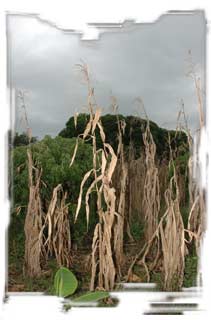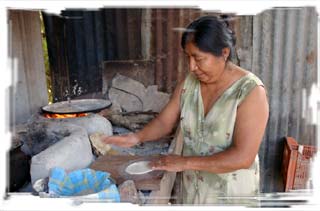CIMMYT E-News, vol 3 no. 11, November 2006
 A CIMMYT scientist is working to see if instead of replacing old varieties with “new and improved”, it is possible to combine the best of the new while retaining the old.
A CIMMYT scientist is working to see if instead of replacing old varieties with “new and improved”, it is possible to combine the best of the new while retaining the old.
In the village of Tumbadero, Mexico, adjacent to CIMMYT’s Agua Fría maize research station, the farmers place a very high value on their traditional varieties. The maize they grow has small ears so it does not yield much. What makes each ear special is a long husk that dwarfs it. The village is close to a major transportation route and traders pay a premium for the husks, which are used to wrap one of Mexico’s most famous foods, the tamale. “We make more money selling the husks than we do selling the grain” says Ruben López, a farmer in the village. But he and the other villagers have a problem: storing the ears without their husks is an open invitation to insects to feast on the maize. With so little yield, saving every grain possible for food is extremely important.
Less than a hundred kilometers from Tumbadero is another village—Cañada Rica. It is well off the beaten track and far from traders. Farmers like Eva Cruz care much more about the cooking quality of the maize flour than they do about the husks, which they cannot sell. Eva uses husks as kindling for the fire on which she cooks tortillas each morning. “Our maize makes the best tortillas,” she says. “They are thick and filling, much better than ones you make with maize flour from the store.” But Eva Cruz’s maize is not without problems either. Storage pests attack her harvest regularly, just as they do the maize in Tumbadero.

Clearly the traditional varieties grown by the farmers of these two villages are very different and have been bred by them to meet specific needs. Each variety is also well-adapted to its local environment. Farmers have no desire to abandon those traits, but also need maize that yields, stores, and tolerates stress better than their traditional varieties. That conundrum became a challenge for Dave Bergvinson, a CIMMYT entomologist who specializes in maize pests. “What if, instead of breeding whole new varieties on a mass scale, you gave the farmers themselves a chance to breed their own?” asks Bergvinson. “You take their best and combine it with our best and then let them do the rest.” To test the idea, he is working with farmers in isolated, economically disadvantaged regions in Mexico. He takes seed from farmers to a CIMMYT research site, like the station at Agua Fría, where he can cross it with CIMMYT maize that has the characteristics missing in the farmers’ varieties. Each cross is specific to a particular village or farmer. After one season of crossing, Bergvinson selects the progeny that perform the best and most closely match farmer preferences for husk, grain type, adaptation, and other traits. Finally, he returns seed of the improved local variety to the farmers. From then on each farmer has what is basically his traditional variety, but with certain improved characteristics.
According to Bergvinson, CIMMYT lacks the resources to carry out such work on a global scale. “It’s not a mass, large-scale solution,” says Bergvinson. “But it is a way of getting to the small pockets of deep poverty and giving those farmers a chance.” It also provides another way for breeders to get a true sense of what end-users of breeding products—the farmer and consumer—consider important.
The pilot project is only in it’s fourth season and there is much analysis to be done, but farmers like Eva Cruz and Ruben López have grown their new seed and can see the improvement. They also see that the traits they value so much in their maze have not been lost.
For more information, David Bergvinson (d.bergvinson@cgiar.org)

